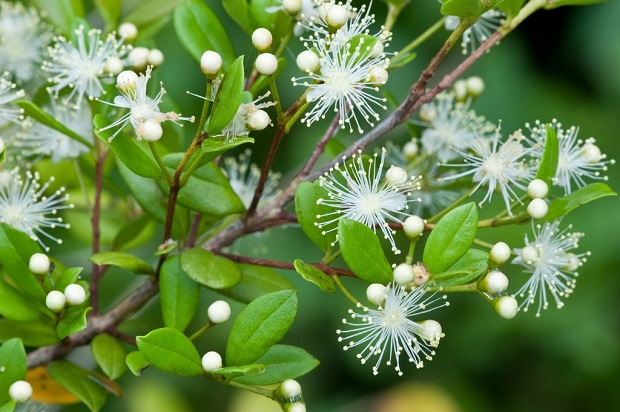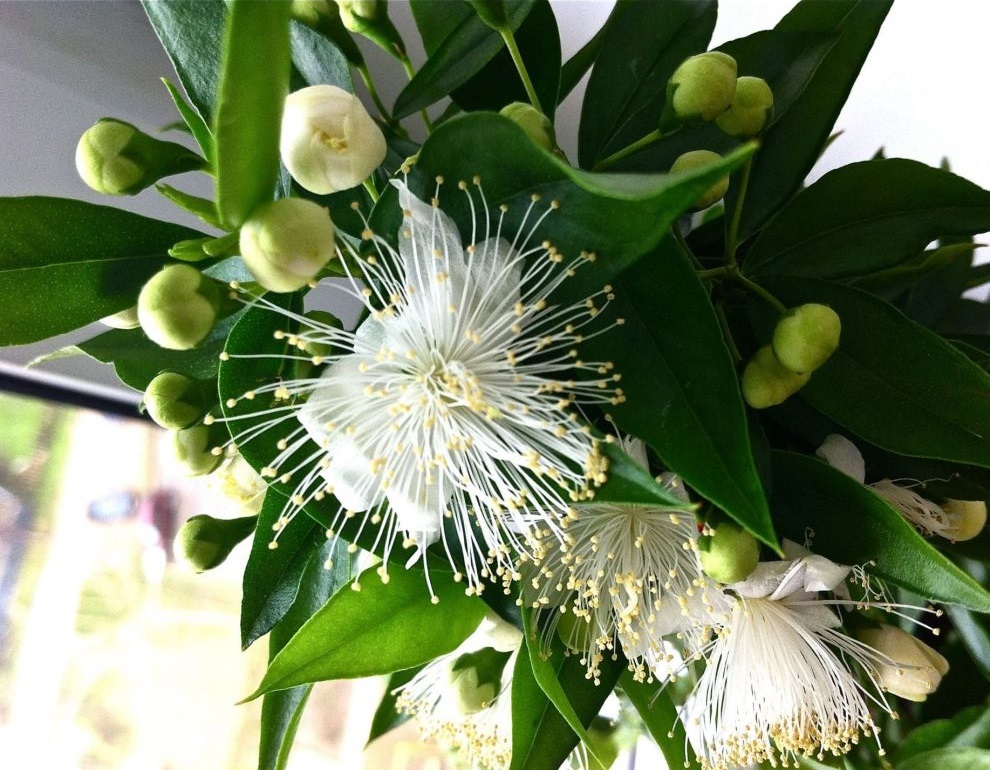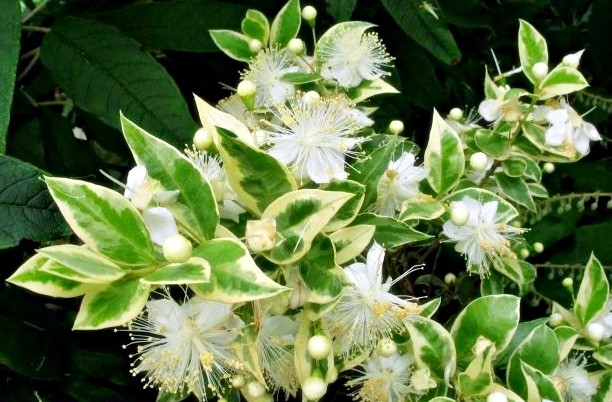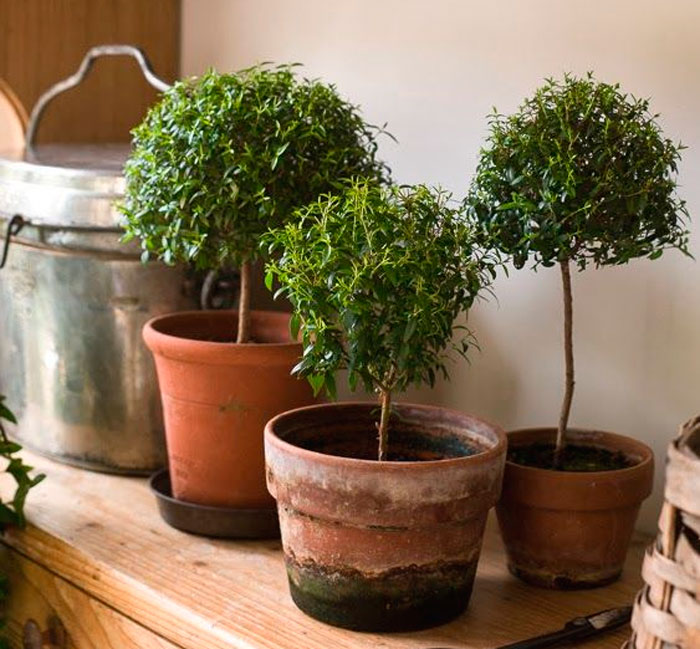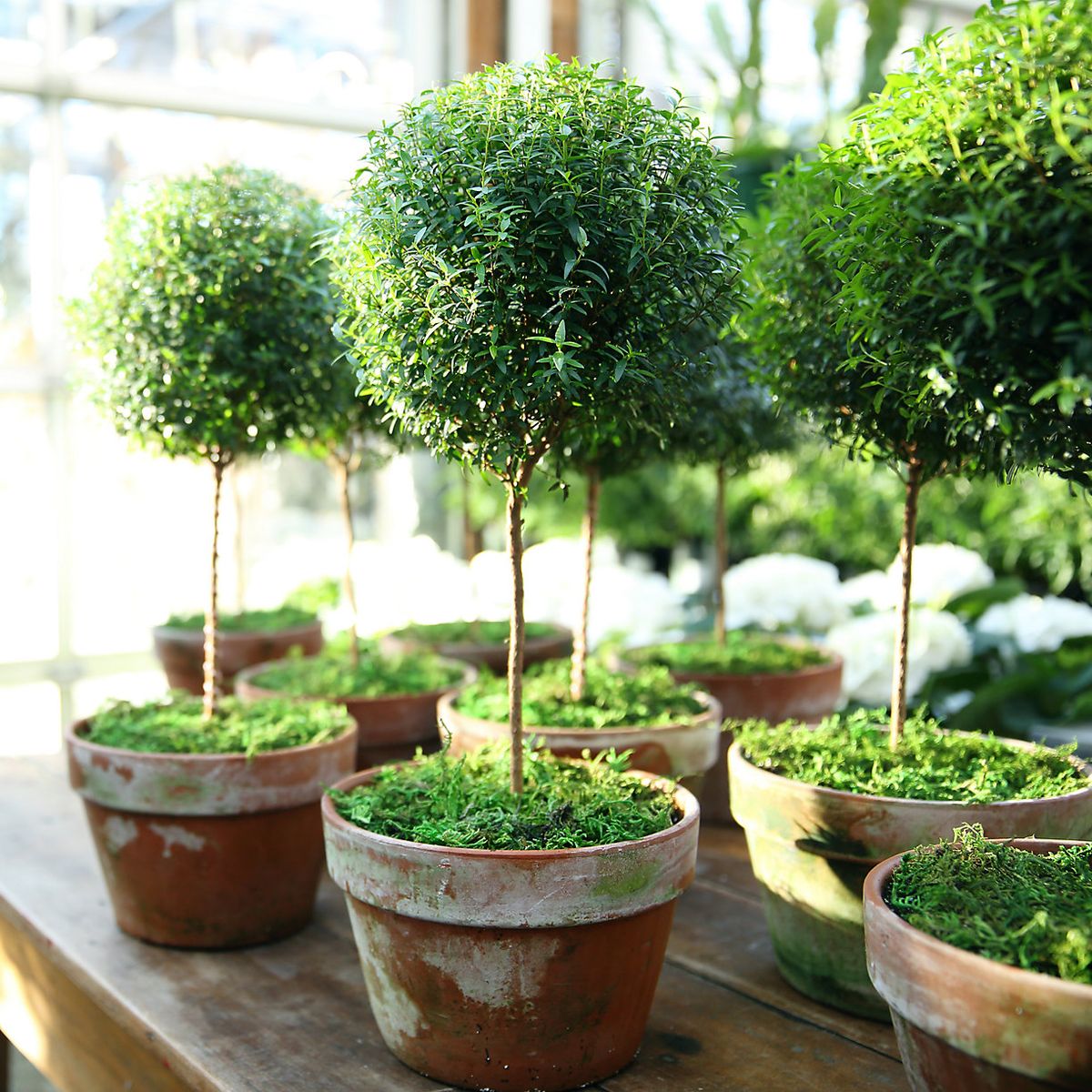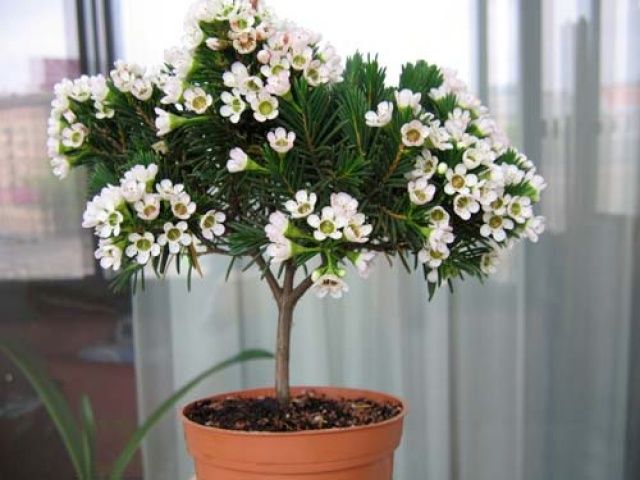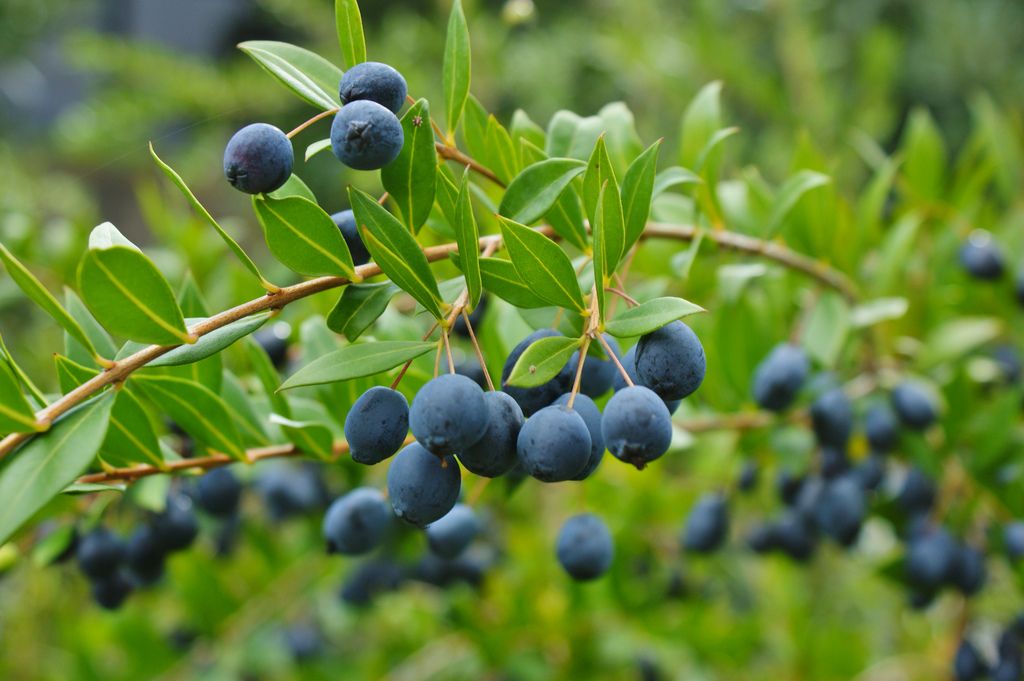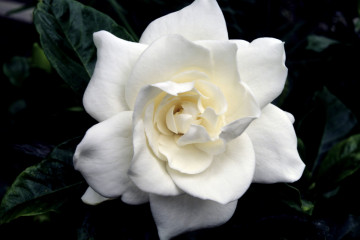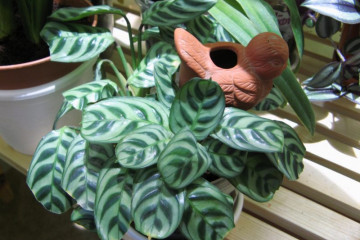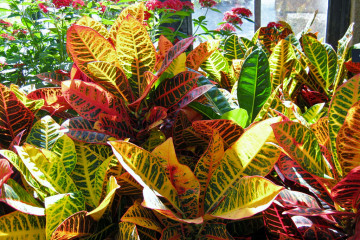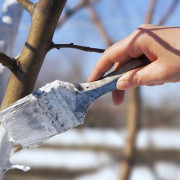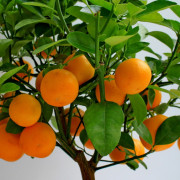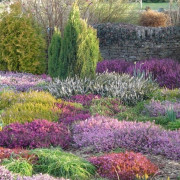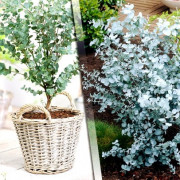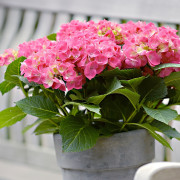Indoor plant myrtle - home care
Content:
The myrtle tree is mentioned in the Bible and in other sacred books of antiquity. People revered this plant for its snow-white flowers and strong aroma. Over time, they began to grow it as an indoor flower.
What does myrtle look like, which family does it belong to
Several dozen different species belong to the Myrtle genus. They grow in tropical and subtropical climates. The homeland of this plant is the Mediterranean. There, myrtle is grown in the open field. It is used in single plantings, landscape compositions are made with it. Some types of myrtle can be grown for hedges.
In colder climates, myrtle is kept in a room or greenhouse. Only one type of this plant is suitable for growing at home - common myrtle (Myrtus communis). It is an evergreen shrub from the Myrtaceae family. It is widespread not only in the wild, but also in the group of horticultural crops.
African myrtle is often called myrsine Africana tree. Outwardly, it is very similar to Myrtus communis, but these are two completely different plants.
Common myrtle should also not be confused with Chilean (Luma apiculata) - spiky luma. This plant also belongs to the Myrtaceae family, but has nothing to do with the indoor Myrtus communis.
The description and characteristics of this plant contain many details. It is a low tree. Indoor myrtle is a bonsai, that is, a miniature copy of a tall tropical plant. In their natural environment, the height of trees reaches 3 - 5 meters. At home, the bush grows up to 60-100 cm, occasionally up to 2 meters.
On a thin trunk is a spreading crown of small shiny emerald green leaves. Each leaf is oval and slightly pointed at the end. Myrtle leaves contain aromatic essential oils from which incense is made.
The crown of the myrtle is covered with small flowers, the diameter of which is about 2 cm. Each flower consists of 5 white rounded petals. Sometimes you can see light myrtle flowers with a creamy, pink or reddish tint. The flowers look fluffy thanks to the long villi growing from their core.
After the end of the flowering period, pea-sized fruits are tied on the tree. Ripe berries are dark blue or dark green in color. They contain seeds with which the tree can be propagated.
Wood traditions
The myrtle tree symbolizes spiritual purity, eternal love, fidelity. Many wedding ceremonies are associated with it. The brides weaved myrtle flowers into their hair, attached them to dresses and veils, and collected bouquets from them.
In the era of Antiquity, myrtle was an attribute of the goddess of love Aphrodite (Venus). Catholics consider this flower to be a symbol of the Virgin Mary. In Victorian England, myrtle wreaths and bouquets were used in royal weddings. Many peoples had the custom of planting myrtle after the birth of a daughter and growing it before her wedding. This plant is kept at home as a talisman.
Common varieties
Myrtle is a houseplant that is famous for its variety of varieties.
Among them are some of the most popular:
- Boetica (Boetica) is a rare large-leaved variety. Its leaves grow up to 6-7 cm in length. Sometimes they twist and take on an interesting shape. Large fluffy white flowers bloom on the bush. Of these, black oval-shaped berries ripen. This variety grows very slowly.
- Flore Pleno - double snow-white flowers and bright green leaves of graceful shape.
- Variegata (Variegata) is a variegated plant: yellowish spots are located on green leaves. Sometimes there are leaves edged with a light border.
- Microfilla (Mycrophylla) is a dwarf tree with small flowers and foliage.
- La Clape - growing rapidly. Large purple fruits ripen from its flowers.
- La Clape Blanc is a variety with white fruits.
- Tarentina is a small-leaved variety. Its dense crown consists of leaves 1–1.5 cm long. Many lush flowers bloom on the tree.
- Tarentina Granada (Tarentina Granada) - flowers turn into white berries.
- Tarentina Variegata is a variegated variety with white-green leaves.
- Microfilla Tarentina is a miniature variety.
- Alhambra (Alhambra) - oblong leaves in a dense crown. White fruits ripen from flowers.
- Leucocarpa - The name of the variety describes the color of its fruit: white berries.
- Compacta (Compacta) - glossy green leaves form a dense crown, crowned with double white flowers.
Healing properties
Myrtle is a flower of extraordinary beauty. But it is grown not only for decoration. This plant has many beneficial properties and is used for the preparation of medicines, aromas and cosmetics.
Foliage, bark and flowers are rich in essential oils that contain phytoncides. These substances purify the indoor air. Therefore, the myrtle growing in the room protects people from viruses, bacteria, colds and allergies, gives vigor, calms the nervous system.
In ancient times, decoctions and tinctures from this plant were used to treat tuberculosis, diphtheria, inflammatory processes in the body, wounds and suppuration. Wine tincture was considered a panacea for all ailments. There are popular recipes according to which healing agents for skin care are prepared from myrtle petals and foliage. The berries of this plant are used in cooking as spices.
Features of caring for myrtle at home
Myrtle is a houseplant, which is not too difficult to care for, but it will require attention and a responsible attitude. It is necessary to create suitable conditions of detention. A flower grower should know how to care for myrtle, how often to water, feed, cut, replant.
Temperature
It is necessary to know firmly in what climate myrtle grows: home care consists in maintaining a favorable temperature regime. In summer, the plant thrives at + 23 ° C.
In winter, the temperature in the room should not drop below +10 ° C.
Lighting
Photophilous myrtle needs abundant diffused lighting, so you need to choose a sunny but slightly shaded place for it. Direct sunlight can burn its crown and petals.
A tree in a tub can be placed on a terrace, balcony, veranda.It is advisable to choose windows facing east or west for it.
- The south window must be covered with curtains or blinds, this is not the best place for indoor flowers.
- On the north window, the flower will be saved from the summer heat, but in winter it will not have enough light.
- If myrtle suffers from a lack of lighting during the autumn and winter months, a lamp should be placed next to it.
Watering
A tropical flower does not tolerate drought, so it must be watered regularly and abundantly. Do not allow the soil to dry out. But it is also worth pouring the plant, because its roots can rot.
In summer, myrtle is watered daily, and in winter - 1-2 times a week. Water needs to be defended during the day.
Spraying
Myrtle is a plant accustomed to humid subtropical climates. Therefore, it must be sprayed every day with settled water from a spray bottle.
In extreme heat, the plant is sprayed 2-3 times a day. In winter, this should be done much less frequently.
Humidity
There are several ways to help increase the humidity for myrtle. Several bowls of water should be placed next to it. You can also put a pot of myrtle on a pallet containing wet expanded clay or gravel.
Priming
To grow myrtle, you need good soil. It is prepared from several components:
- humus - 20%;
- peat - 30%;
- turf - 30%;
- sand - 20%.
All components are mixed and watered with a weak solution of potassium permanganate. Greenhouse soil may also be suitable for cultivation. Drainage must be placed on the bottom of the pot - perlite, expanded clay, vermiculite.
Top dressing
In the period from March to October, you need to feed the myrtle once every 1-2 weeks. In winter, feeding is carried out once a month. For this, both organic and complex mineral fertilizers are used.
Potassium-phosphorus preparations stimulate the flowering of the tree, and nitrogenous ones keep the plant small.
When and how it blooms
Myrtle will bloom in June and July: from the very first days of summer to mid-summer. Fragrant flowers bloom from the buds.
Types of flowers
There are two types of flowers:
- simple;
- terry.
They consist of 4-6 petals, which are round or pointed.
Flower shapes
There are two main forms of myrtle flowers. They can be collected in clusters and inflorescences. In other varieties, each flower is individually attached to the leaf axil.
Most flowers bloom at the top of the crown, where more light enters. Flowering lasts about 1.5 months. Then the berries are tied.
Changes in care during flowering
Blooming myrtle needs ventilation, so it should be placed on a balcony or other open area. Shoot pruning should be done after flowering is complete, but not in early spring.
Pruning
A young tree should be pinched when it reaches 10–20 cm in height. This will allow the crown to grow densely. An adult bush needs to be shaped. For this, shoots are pruned.
It is advisable to leave more side branches, because the stem is fragile. Garden shears or pruning shears are pre-disinfected. After this procedure, the plant is fed with chlorine-free fertilizers.
How myrtle reproduces
Myrtle is propagated by seeds or cuttings. The first method is very time consuming and time consuming. In addition, the seeds do not retain the properties of the parent plant. Therefore, cuttings are much more preferable.
Germinating seeds
Reproduction by seeds:
- Prepare the substrate and pour plenty of water over it.
- Sow seeds and sprinkle them with a thin layer of earth.
- Cover the box with glass or plastic.
- After 2 weeks, transplant the seedlings into small pots.
Rooting cuttings
Planting cuttings:
- During one of the pruning, a strong lateral shoot is taken from the tree, on which there is no flowering.
- The lower leaves are removed from the cuttings 6–10 cm long.
- At the bottom, the cut is treated with a root growth stimulator. You can put the stalk in water in which the stimulant is dissolved.
- The stalk is rooted in a wet substrate and covered with a plastic bottle.
- After 3-4 weeks, they are transplanted into large pots.
Transfer
Young trees should be replanted once a year. Their root system grows wider, so they need a larger pot (3.5 cm wider).
Mature and old trees can live in one tub for 3-4 years. The transplant is carried out in winter, when the plant is at rest. In a new wide container, drainage and fresh soil are prepared. After that, the myrtle must be removed from the old pot and transplanted into a new one. After that, it is watered and fed.
Possible problems in growing myrtle
Myrtle is an indoor flower, so it is not too difficult to care for it. However, difficulties may arise. Then the flower growers seek to find out why the tree does not bloom, withers and dries up, what kind of care it needs. This plant is easy to revive.
Drops buds and leaves
Incorrect temperature and humidity conditions lead to the dropping of buds and crowns. It may also indicate inappropriate lighting and poor feeding.
Leaves turn pale
Due to the lack of light, the leaves turn pale, and the branches stretch in length. The myrtle should be rearranged to a more illuminated place. Due to the harsh rays of the sun, the leaves become dull.
The tips of the leaves dry
Direct sunlight burns the foliage, causing it to dry out. This is caused by insufficient air humidity.
The lower leaves fall
There can be several reasons for foliage to fall:
- dry air;
- lack of fertilizers;
- too sparse or too abundant watering;
- lack of sun.
Pests
Such parasites are dangerous for a plant:
- thrips;
- aphid;
- shield;
- whitefly;
- spider mite.
The tree is treated with insecticides several times.
Other problems
Roots and base of the stem can rot. This is due to excess moisture. The plant will die, it cannot be cured.
Myrtle is a wonderful plant to grow in your home. For many years it will delight the grower with delicate flowers and a pleasant aroma. For these qualities, he was considered a sacred flower.
